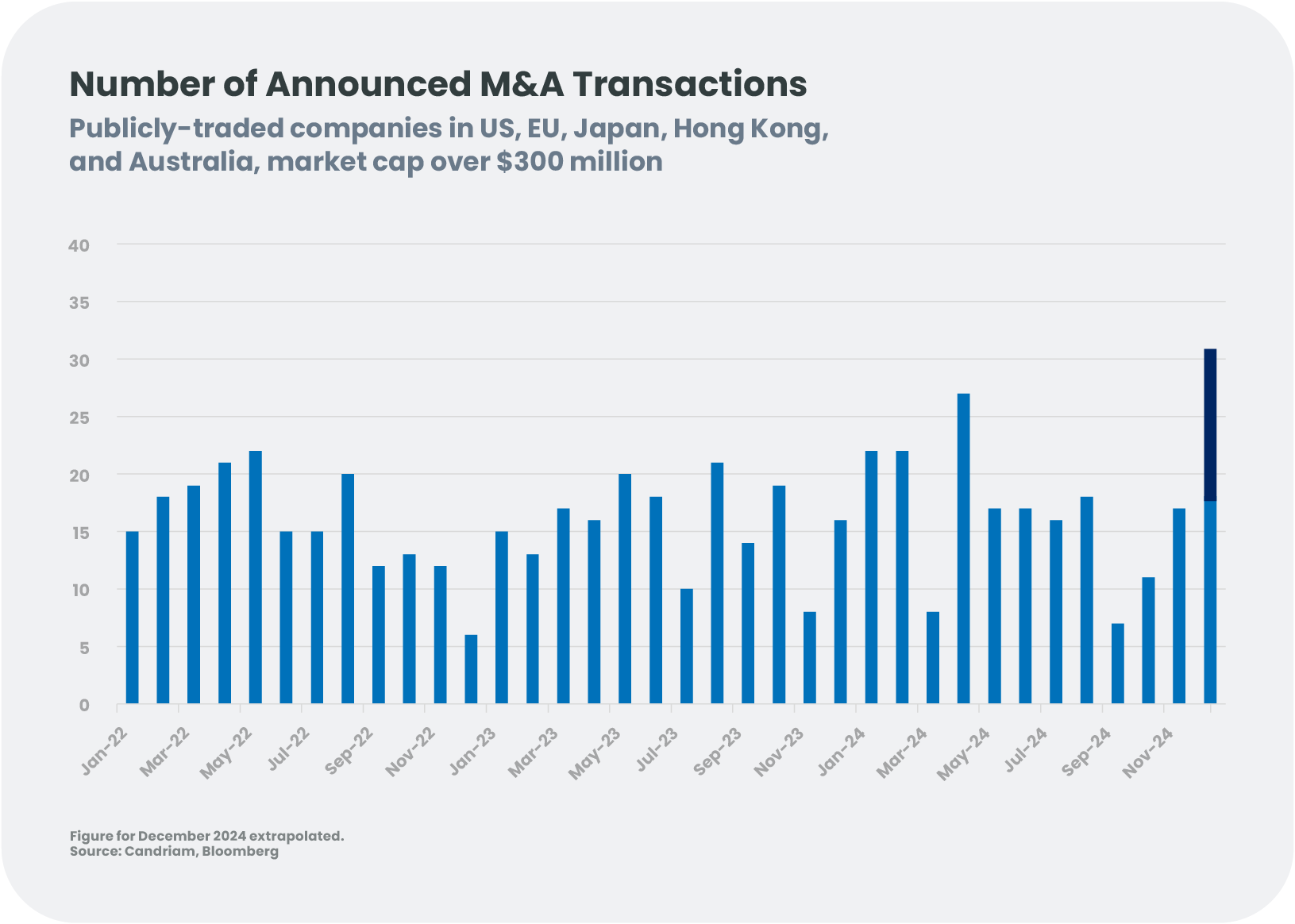
Introduction
As we head into 2025, the stars seem to be aligning for a revival of mergers and acquisitions, creating a fertile environment for investors seeking new opportunities. Merger arbitrage strategies attempt to capitalize on M&A activity by using a structured approach returns. Much like other alternative investment strategies, merger arbitrage can enhance the quality and consistency of the performance of a portfolio of asset classes, while contributing to diversification and resilience in an evolving market landscape.
The M&A Landscape: from Headwinds to Tailwind?
Over the past three years (2021 to 2024), the M&A environment faced challenges. Persistent economic uncertainty, rising interest rates, and a stricter regulatory landscape weighed on deal-making activity:
- Economic uncertainty: Elections in the US, the UK, Japan, France and Germany as well as geopolitical conflicts in Ukraine and the Middle East exacerbated global economic uncertainty.
- Deteriorating financing conditions: Central banks in the US and Europe dramatically[1] raised interest rates, while the premium on borrowing costs rose for leveraged loans as demand plummeted.
- Regulatory pressures: Under FTC[2] Chairman Lina Khan, American antitrust enforcement took a more dogmatic stance, diverging from the approach traditionally used by regulators to assess competition impacts of mergers. This led to numerous challenges for transactions across sectors that would have otherwise been cleared rapidly, such as the rejected combinations of grocery leaders Albertsons and Kroger or the terminated merger between large fashion operators Capri (brands such as Michael Kors) and Tapestry (Coach) in 2024.
These headwinds damped down M&A activity across North America and Europe, which collectively account for more than two-thirds of global deal flow.[3]
As we approach 2025, we see conditions shifting in favour of an M&A revival:
- Lower inflation and growth expectations provide a more stable environment for dealmakers.
- Interest rates cuts make it easier for companies to secure funding for acquisitions and boost expected returns, with further rate reductions to be expected over the next 12 months.
- Corporate and investor cash reserves are at record levels, with private equity firms holding unprecedented amounts of deployable capital.
- The recent US elections, resulting in a Republican president and legislature, signal a shift toward pro-business policies, including corporate tax cuts and streamlined regulatory processes. For instance, the 2017 Tax Cuts and Jobs Act reduced domestic taxes to levels comparable to international tax havens and introduced exemptions for repatriated earnings.
US Leadership of the M&A Revival
The new Trump administration is expected to adopt a more relaxed regulatory approach in the US, particularly from the Federal Trade Commission (FTC) and the Department of Justice (DOJ), which oversee mergers and acquisitions. President-elect Trump most recently nominated Andrew Ferguson and Gail Slater to lead those two federal agencies. Both have publicly stated clear opposition to the policies of their predecessors, with Ferguson going as far as to vow he would “stop Lina Khan’s war on mergers”, sending a strong ‘all clear’ signal to corporates and financial buyers.
While US domestic deal-making activity is likely to surge, foreign buyers could face barriers due to protectionist policies. For example, if the Administration prioritises reducing dependency on foreign technology, it could incentivise American firms to acquire domestic tech startups to maintain innovation and security. As noted by international law firm Rooney Law, such measures could bolster the US technology sector.
Deal announcements have already increased double-digit versus year-to-date rates since the November 5th election, with Wall Street bankers reporting a significant uptick in client inquiries. Considering that traditional due diligence processes would take a few weeks or months to complete, this should bode well for M&A activity as soon as early 2025. After years of sidelined activity and accumulating cash reserves, companies are now eager to pursue deals, even those previously considered challenging. A notable example is the recently announced $30 billion merger between advertising giants Interpublic and Omnicom.

Investment Opportunities in M&A
M&A-related strategies, such as risk arbitrage, aim to t capitalise on inefficiencies in the price movements of the companies involved in takeovers or mergers. In a time when equities and fixed income appear to be relatively expensive, the returns on these strategies have low correlations with markets as their risks are idiosyncratic. As a matter of fact, when a company is about to be acquired or merged, its share price ceases to be determined by its fundamentals, ie its financial performance, but rather by news about the pending transaction. Investors are rewarded for the fulfilment of certain conditions attached to each specific transaction, such as the required shareholder vote or antitrust approvals. As a result, stocks involved in mergers and acquisitions tend to move independently of the market as a whole and of each other. A merger arbitrage strategy can offer advantages such as low exposure to market trends, given the historically low transaction failure rate (5%), which means controlled volatility and stable returns. This can make this strategy a good portfolio diversifier.
Finally a Little Predictability?
With a more favourable backdrop for mergers and acquisitions, 2025 could mark the return of a vibrant M&A market. Moderating interest rates and the new Republican majority in the US pave the way for a pro-business agenda, including corporate tax cuts and easing regulatory burdens. For investors, this environment may highlight the renewed relevance of strategies tied to corporate activity, offering attractive opportunities to navigate a complex and evolving financial landscape.











